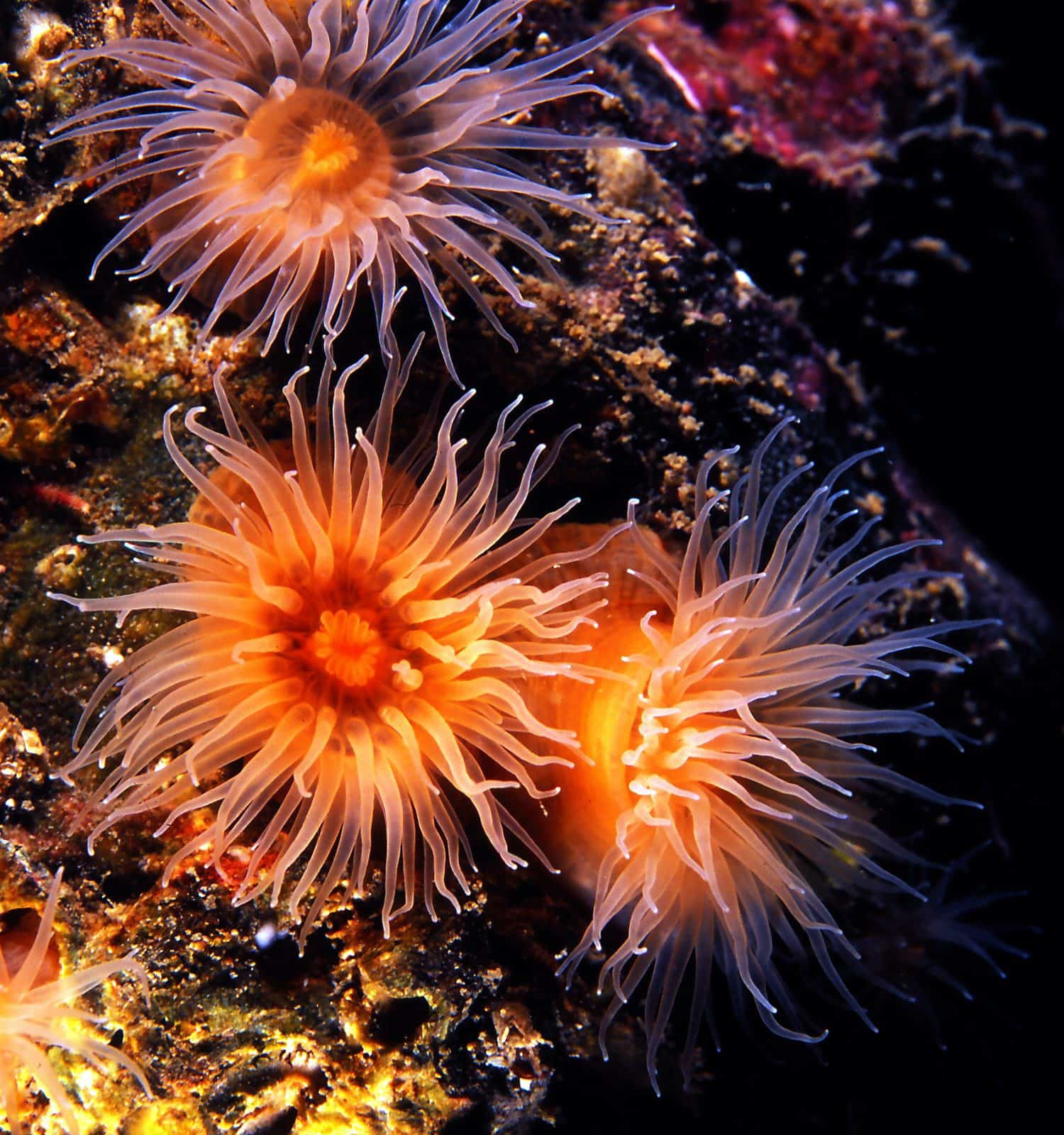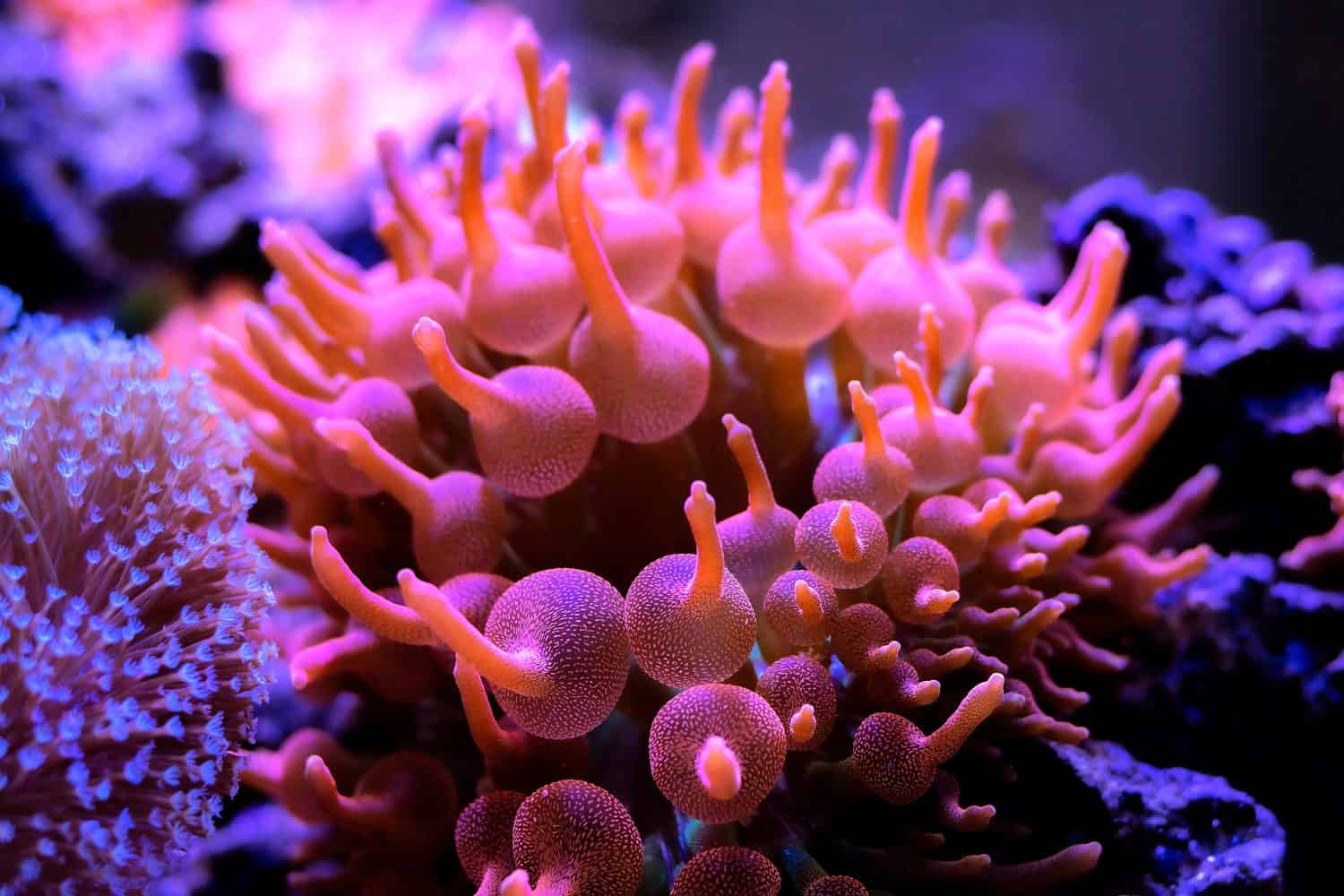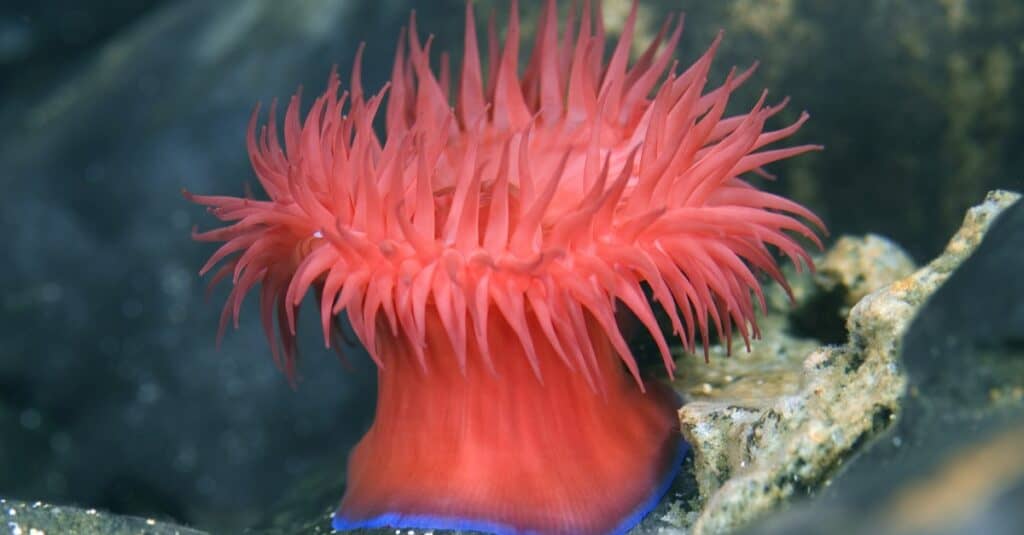If you are putting together an aquarium for your home or business (or just like learning about fascinating sea creatures), we have a list that is sure to get you orange with excitement. These orange anemones add color and interest to any underwater environment. Some are small and suitable for an in-home aquarium. Others are massive and one of the showstoppers for scuba divers and snorkelers.
Many sea anemones look like plants but they are actually animals. There are around 1,000 known species of anemones in all kinds of colors, shapes, and sizes. But large areas of the ocean are unexplored so who knows how many additional anemones might be out there!
The long “leaves” of the anemone are actually hollow tubes that have tentacles to sting and paralyze prey. Most sea creatures steer clear of anemones except the unfortunate ones who swim too close. They get stung and swept into the anemone’s mouth. Some fish, such as the clown fish (also orange) live in a symbiotic relationship with anemones. They have a coating of mucus that protects them from the anemone’s sting and can live within the shelter that the anemone provides. In return, the clownfish takes care of parasites and potential predators that could harm the anemone.
1. Orange Anemone (Diadumene cincta)

These anemones attach to rocks or walls.
©valda butterworth/Shutterstock.com
This anemone is small, usually less than 1.5 inches tall. It has around 200 tentacles around its mouth. The central portion is typically darker orange than the tentacles. Some groups of these orange anemones have larger and thicker tentacles among the more plentiful slender ones. These are called catch tentacles, although not all anemones within this species have them. The column where the oral disc and tentacles are located is very elongated compared to many other anemones. When it is fully extended, the anemone has a worm-like appearance.
It tends to live in the northeastern part of the Atlantic Ocean as far north as parts of the North Sea. They are most common around Great Britain and France. They prefer shallower water and won’t generally go any deeper than 130 feet. These orange anemones attach to shells, rocks, and any other hard surface that they can find. They’ll even attach to and grow on shipwrecks. These anemones tend to stay in larger groups, called aggregations.
2. Orange Sunburst Anemone (Entacmaea quadricolor)

These anemones are called bubble-tip anemones for their oddly shaped tentacles.
©Vojce/Shutterstock.com
Also known as a bubble-tip anemone, this species is named for both its appearance and color. They have round tips on their tentacles that look like bubbles. They can be a variety of colors including orange and red but rose, a soft orange color, is one of the most popular for home aquariums. Unhealthy bubble-tip anemones are translucent or white due to not having enough zooxanthellae, a symbiotic cellular organism that needs light to go through photosynthesis. This process is called bleaching because of the discoloration that occurs. Without its zooxanthellae, the anemone will eventually die.
It does well in an aquarium under the right conditions and is popular with those who want to add anemones to their aquarium. Your aquarium environment should be well established before you introduce an anemone, however. Around 6 months is generally recommended. They play host to clownfish as well as other anemonefish in the wild so they make a great addition to aquariums with these fish in them. These are relatively easy to keep, as far as anemones go, but still require the right knowledge and environment. You should have something for the anemone to attach to, the right amount of light, and the right amount of flow through the water. Adults prefer dimmer light while young anemones need bright light.
3. Orange Tube Anemone (Cerianthus membranaceus)

The outer whorl of tentacles is often a different color than the inner whorl of tentacles in these anemones.
©sirtravelalot/Shutterstock.com
These anemones come in a variety of colors but orange is one of the most striking. They have around 200 tentacles organized into two whorls. The outer whorl and inner whorl are often contrasting colors, such as orange and green. The outer whorl tentacles have stingers and are generally longer and more prominent than the inner whorl, which is used to move food into the anemone’s mouth. These anemones eat small fish, plankton, and invertebrates in the wild. If you are keeping them in an aquarium, you can cut up chunks of fish or feed them small pieces of clam or mussels. Make sure that any other fish in the aquarium with them are too big for the tube anemone to eat. Otherwise, you might find that you are missing a fish or two if they get too close to the anemone.
They secrete their tubes, which become firmer and sturdier as sand and other particles attach. They bury the base in the sand or other substrate below. When they feel threatened, the anemone retreats into the tube. The outer whorl of tentacles actually pulls the opening closed, protecting the anemone even more. In true emergencies, the anemone can vacate the tube and move to a new location. There, they’ll bury and secrete a new tube, hopefully away from imminent danger. They can live as long as 50 years, possibly more.
4. Giant Golden Anemone (Condylactis gigantea)

The tips of the giant golden anemone’s tentacles can be pink or purple.
©Damsea/Shutterstock.com
These large anemones are amazing to see. They live in shallow water, especially reefs, so you’re likely to see them if you go snorkeling or scuba diving in the Caribbean or the Florida Keys. Giant golden anemones tend to stay solitary or in small groups that are still relatively spread out. They don’t occur in larger colonies or aggregations. These anemones like seawater, the saltier the better, and attach to rocks or other hard surfaces. They are plentiful in parts of the Caribbean and easy to recognize, especially if they have the tell-tale colored tips on their tentacles.
It is around 6 inches tall and 12 inches in diameter. These orange anemones (although they come in other colors as well) have around 100 tentacles. The tentacles are generally lighter than the larger body of the anemone. However, the tips of the tentacles can have a distinct color, even one that is different than the rest of the anemone. Unlike some other anemone species, giant golden anemones move by crawling on their basal discs along the ocean floor, reef, or other substrate. Don’t expect them to be winning any races, however, since this movement is quite slow.
5. Beadlet Anemone (Actinia equina)

Beadlet sea anemones have a lot of tentacles with an upright body.
©David Havel/Shutterstock.com
This sea anemone sure gets around. It lives around Great Britain as well as in parts of the Mediterranean, the Adriatic, the Atlantic coast of Africa, and elsewhere. It lives in coastal areas and can even live in areas with variable salinity. They live alone or in aggregations. They can live when the tide goes out by retracting their tentacles. In this case, they look more like a colored blob than an actual ocean animal. Once the tide comes back in, however, and they are safely underwater, these anemone put their tentacles back out as well.
These anemones have just over 190 tentacles arranged in six concentric circles. Out of the water, these tentacles retract. The body is around 2 inches and can be orange, red, brown, or a number of other colors. Unlike some anemones that reproduce externally in the water or asexually, beadlet anemones are viviparous. This means that the young anemones grow and develop within the mother’s body until they are ready to be born.
The photo featured at the top of this post is © Dr. Victor Wong/Shutterstock.com
Thank you for reading! Have some feedback for us? Contact the AZ Animals editorial team.






